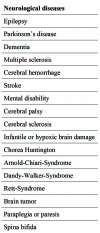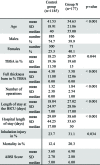Influence Of Pre-Existing Neurological Illnesses On The Outcome Of Severe Burn Injuries
- PMID: 34054384
- PMCID: PMC8126361
Influence Of Pre-Existing Neurological Illnesses On The Outcome Of Severe Burn Injuries
Abstract
It is known that patients suffering from neurological illnesses have an increased risk of burn injuries. These burns are often very severe and lead to poor outcomes. To date, only a few studies have evaluated the impact of pre-existing neurological illnesses on the outcome of burn injuries. None of them performed a regression analysis regarding specific influence on mortality. Between 1996 and 2016, 1475 patients were admitted to the BICU of a specialized German burn center: 26 had less than 1% TBSA burned and were excluded; 177 had pre-existing neurological disorders (group N). 87 patients with psychological disorders were excluded. 1185 patients without neurological or psychological disorders formed the control group. Length of hospital stay, TBSA and number of operations were analyzed using the chi-squared test and Mann-Whitney U-test. Additionally, mortality was evaluated using the logistic regression analysis adjusted for known outcome predictors. Mean age of the patients in the control group was 41.53 years with a BICU stay of 18 days, TBSA of 18.25% and mortality rate of 12.4%; 23.7% had inhalation injuries. Patients in group N had a mean age of 54.63 years, a BICU stay of 27 days, mean TBSA of 20.97%; 31.1% had inhalation injuries and mortality was 20.3%. Patients with neurological disorders were older and showed higher affected TBSA, higher rates of inhalation injury, mortality and affected TBSA, and a longer stay in the BICU compared to the control group. Nevertheless, pre-existing neurological disorders alone had no significant influence on mortality.
Il est avéré que les patients souffrant de pathologie neurologique ont un risque plus élevé de brûlure. Elles sont souvent particulièrement graves et d’évolution défavorable mais la littérature à ce sujet reste pauvre et aucune étude n’a utilisé de régression logistique pour évaluer la corrélation pathologie neurologique- évolution d’une brûlure. Entre 1996 et 2016, 1 475 patients ont été hospitalisés en réanimation spécifique dans un CTB allemand. Vingt- six d’entre eux, brûlés sur moins de 1% SCT, n’ont pas été inclus dans l’étude, pas plus 87 patients psychiatriques si bien que 177 patients souffrant de pathologie neurologique (N) ont été comparés à 1 185 n’en souffrant pas (C). Les durées d’hospitalisation, la surface brûlée et le nombre d’interventions chirurgicales ont été analysée en utilisant C² ou Mann-Whitney. En outre, nous avons effectué une régression logistique étudiant la mortalité, en utilisant les facteurs connus de mortalité. Le groupe C avait 41,53 ans, souffrait de brûlures sur 18,25% SCT, avait inhalé des fumées dans 23,7% des cas, avait un taux de mortalité de 12,4% et restait 18 j en réanimation. Dans le groupe N, ces chiffres étaient respectivement de 54,63 ans, 20,97% SCT, 31,1% de fumées, 20,3% de mortalité et 27 jours en réa. Tous les chiffres étudiés étaient plus élevés dans N que dans C. Toutefois, l’existence de comorbidité neurologique n’apparaissait pas un critère indépendant de mortalité.
Keywords: BICU; burn injuries; burn mortality; neurological disorders.
Copyright © 2021 Euro-Mediterranean Council for Burns and Fire Disasters.
Figures




References
-
- Harvey L, Mitchell R, Brodaty H, Draper B, Close J. Dementia: a risk factor for burns in the elderly. Burns. 2016;42(2):282–290. - PubMed
-
- Backstein R, Peters W, Neligan P. Burns in the disabled. Burns. 1993;43(5):192–197. - PubMed
-
- Hudson A, Al Youha S, Samargandi OA, Paletz J. Pre-existing psychiatric disorder in the burn patient is associated with worse outcomes. Burns. 2017;43(5):973–982. - PubMed
LinkOut - more resources
Full Text Sources
